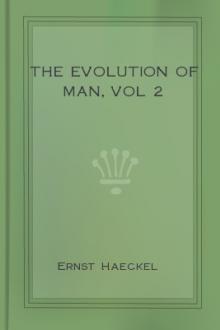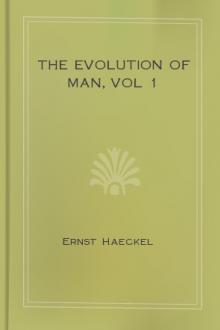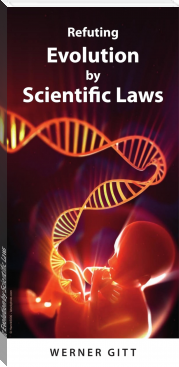The Evolution of Man, vol 2 by Ernst Haeckel (fun books to read for adults TXT) 📕

- Author: Ernst Haeckel
- Performer: -
Book online «The Evolution of Man, vol 2 by Ernst Haeckel (fun books to read for adults TXT) 📕». Author Ernst Haeckel
In every case the duration of ontogeny shrinks into insignificance when we compare it with the enormous period that has been necessary for phylogeny, or the gradual development of the ancestral series. This period is not measured by years or centuries, but by thousands and millions of years. Many millions of years had to pass before the most advanced vertebrate, man, was evolved, step by step, from his ancient unicellular ancestors. The opponents of evolution, who declare that this gradual development of the human form from lower animal forms, and ultimately from a unicellular organism, is an incredible miracle, forget that the same miracle takes place within the space of mine months in the embryonic development of every human being. Each of us has, in the forty weeks—properly speaking, in the first four weeks—of his development in the womb, passed through the same series of transformations that our animal ancestors underwent in the course of millions of years.
It is impossible to determine even approximately, in hundreds or even thousands of years, the real and absolute duration of the phylogenetic period. But for some time now we have, through the research of geologists, been in a position to assign the relative length of the various sections of the organic history of the earth. The immediate data for determining this relative length of the geological periods are found in the thickness of the sedimentary strata—the strata that have been formed at the bottom of the sea or in fresh water from the mud or slime deposited there. These successive layers of limestone, sandstone, slate, marl, etc., which make up the greater part of the rocks, and are often several thousand feet thick, give us a standard for computing the relative length of the various periods.
To make the point quite clear, I must say a word about the evolution of the earth in general, and point out briefly the chief features of the story. In the first place, we encounter the principle that on our planet organic life began to exist at a definite period. That statement is no longer disputed by any competent geologist or biologist. The organic history of the earth could not commence until it was possible for water to settle on our planet in fluid condition. Every organism, without exception, needs fluid water as a condition of existence, and contains a considerable quantity of it. Our own body, when fully formed, contains sixty to seventy per cent of water in its tissues, and only thirty to forty per cent of solid matter. There is even more water in the body of the child, and still more in the embryo. In the earlier stages of development the human foetus contains more than ninety per cent of water, and not ten per cent of solids. In the lower marine animals, especially certain medusae, the body consists to the extent of more than ninety-nine per cent of seawater, and has not one per cent of solid matter. No organism can exist or discharge its functions without water. No water, no life!
But fluid water, on which the existence of life primarily depends, could not exist on our planet until the temperature of the surface of the incandescent sphere had sunk to a certain point. Up to that time it remained in the form of steam. But as soon as the first fluid water could be condensed from the envelope of steam, it began its geological action, and has continued down to the present day to modify the solid crust of the earth. The final outcome of this incessant action of the water—wearing down and dissolving the rocks in the form of rain, hail, snow, and ice, as running stream or boiling surge—is the formation of mud. As Huxley says in his admirable Lectures on the Causes of Phenomena in Organic Nature, the chief document as to the past history of our earth is mud; the question of the history of past ages resolves itself into a question about the formation of mud.
As I have said, it is possible to form an approximate idea of the relative age of the various strata by comparing them at different parts of the earth’s surface. Geologists have long been agreed that there is a definite historical succession of the different strata. The various superimposed layers correspond to successive periods in the organic history of the earth, in which they were deposited in the form of mud at the bottom of the sea. The mud was gradually converted into stone. This was lifted out of the water owing to variations in the earth’s surface, and formed the mountains. As a rule, four or five great divisions are distinguished in the organic history of the earth, corresponding to the larger and smaller groups of the sedimentary strata. The larger periods are then subdivided into a series of smaller ones, which usually number from twelve to fifteen. The comparative thickness of the groups of strata enables us to make an approximate calculation of the relative length of these various periods of time. We cannot say, it is true, “In a century a stratum of a certain thickness (about two feet) is formed on the average; therefore, a layer 1000 feet thick must be 500,000 years old.” Different strata of the same thickness may need very different periods for their formation. But from the thickness or size of the stratum we can draw some conclusion as to the RELATIVE length of the period.
The first and oldest of the four or five chief divisions of the organic history of the earth is called the primordial, archaic, or archeozoic period. If we compute the total average thickness of the sedimentary strata at about 130,000 feet, this first period comprises 70,000 feet, or the greater part of the whole. For this and other reasons we may at once conclude that the corresponding primordial or archeolithic period must have been in itself much longer than the whole of the remaining periods together, from its close to the present day. It was probably much longer than the figures I have quoted (7 : 6) indicate—possibly 9 : 6. Of late years the thickness of the archaic rocks has been put at 90,000 feet.
SYNOPSIS OF THE PALEONTOLOGICAL FORMATIONS, OR THE FOSSILIFEROUS STRATA OF THE CRUST.
COLUMN 1 : Groups (V. down to I.).
COLUMN 2 : Systems (XIV. down to I.).
COLUMN 3 : Formations (38 down to 1).
COLUMN 4 : Synonyms of Formations.
V. Anthropolithic group, or anthropozoic (quaternary) group of strata : XIV. Recent (alluvium) : 38. Present : Upper alluvial.
V. Anthropolithic group, or anthropozoic (quaternary) group of strata : XIV. Recent (alluvium) : 37. Recent : Lower alluvial.
V. Anthropolithic group, or anthropozoic (quaternary) group of strata : XIII. Pleistocene (diluvium) : 36. Post-glacial : Upper diluvial.
V. Anthropolithic group, or anthropozoic (quaternary) group of strata : XIII. Pleistocene (diluvium) : 35. Glacial : Lower diluvial.
IV. Cenolithic group, or cenozoic (tertiary) group of strata : XII. Pliocene (neo-tertiary) : 34. Arverne : Upper pliocene.
IV. Cenolithic group, or cenozoic (tertiary) group of strata : XII. Pliocene (neo-tertiary) : 33. Subapennine : Lower pliocene.
IV. Cenolithic group, or cenozoic (tertiary) group of strata : XI. Miocene (middle tertiary) : 32. Falun : Upper miocene.
IV. Cenolithic group, or cenozoic (tertiary) group of strata : XI. Miocene (middle tertiary) : 31. Limbourg : Lower miocene.
IV. Cenolithic group, or cenozoic (tertiary) group of strata : Xb. Oligocene (old tertiary) : 30. Aquitaine : Upper oligocene.
IV. Cenolithic group, or cenozoic (tertiary) group of strata : Xb. Oligocene (old tertiary) : 29. Ligurium : Lower oligocene.
IV. Cenolithic group, or cenozoic (tertiary) group of strata : Xa. Eocene (primitive tertiary) : 28. Gypsum : Upper eocene.
IV. Cenolithic group, or cenozoic (tertiary) group of strata : Xa. Eocene (primitive tertiary) : 27. Coarse chalk : Middle eocene.
IV. Cenolithic group, or cenozoic (tertiary) group of strata : Xa. Eocene (primitive tertiary) : 26. London clay : Lower eocene.
III. Mesolithic group, or mesozoic (secondary) group of strata : IX. Chalk (cretaceous) : 25. White chalk. : Upper cretaceous.
III. Mesolithic group, or mesozoic (secondary) group of strata : IX. Chalk (cretaceous) : 24. Green Sand : Middle cretaceous.
III. Mesolithic group, or mesozoic (secondary) group of strata : IX. Chalk (cretaceous) : 23. Neocomian : Lower cretaceous.
III. Mesolithic group, or mesozoic (secondary) group of strata : IX. Chalk (cretaceous) : 22. Wealden : Weald-formation.
III. Mesolithic group, or mesozoic (secondary) group of strata : VIII. Jurassic : 21. Portland : Upper oolithic.
III. Mesolithic group, or mesozoic (secondary) group of strata : VIII. Jurassic : 20. Oxford : Middle oolithic.
III. Mesolithic group, or mesozoic (secondary) group of strata : VIII. Jurassic : 19. Bath : Lower oolithic.
III. Mesolithic group, or mesozoic (secondary) group of strata : VIII. Jurassic : 18. Lias : Liassic.
III. Mesolithic group, or mesozoic (secondary) group of strata : VII. Triassic : 17. Keuper : Upper triassic.
III. Mesolithic group, or mesozoic (secondary) group of strata : VII. Triassic : 16. Muschelkalk : Middle triassic.
III. Mesolithic group, or mesozoic (secondary) group of strata : VII. Triassic : 15. Bunter : Lower triassic.
II. Paleolithic group, or paleozoic (primary) group of strata : VIb. Permian : 14. Zechstein : Upper permian.
II. Paleolithic group, or paleozoic (primary) group of strata : VIb. Permian : 13. Neurot sand : Lower permian.
II. Paleolithic group, or paleozoic (primary) group of strata : VIa. Carboniferous (coal-measures) : 12. Carboniferous sandstone : Upper carboniferous.
II. Paleolithic group, or paleozoic (primary) group of strata : VIa. Carboniferous (coal-measures) : 11. Carboniferous limestone : Lower carboniferous.
II. Paleolithic group, or paleozoic (primary) group of strata : V. Devonian : 10. Pilton : Upper devonian.
II. Paleolithic group, or paleozoic (primary) group of strata : V. Devonian : 9. Ilfracombe : Middle devonian.
II. Paleolithic group, or paleozoic (primary) group of strata : V. Devonian : 8. Linton : Lower devonian.
II. Paleolithic group, or paleozoic (primary) group of strata : IV. Silurian : 7. Ludlow : Upper silurian.
II. Paleolithic group, or paleozoic (primary) group of strata : IV. Silurian : 6. Wenlock : Middle silurian.
II. Paleolithic group, or paleozoic (primary) group of strata : IV. Silurian : 5. Llandeilo : Lower silurian.
I. Archeolithic group, or archeozoic (primordial) group of strata : III. Cambrian : 4. Potsdam : Upper cambrian.
I. Archeolithic group, or archeozoic (primordial) group of strata : III. Cambrian : 3. Longmynd : Lower cambrian.
I. Archeolithic group, or archeozoic (primordial) group of strata : II.





Comments (0)